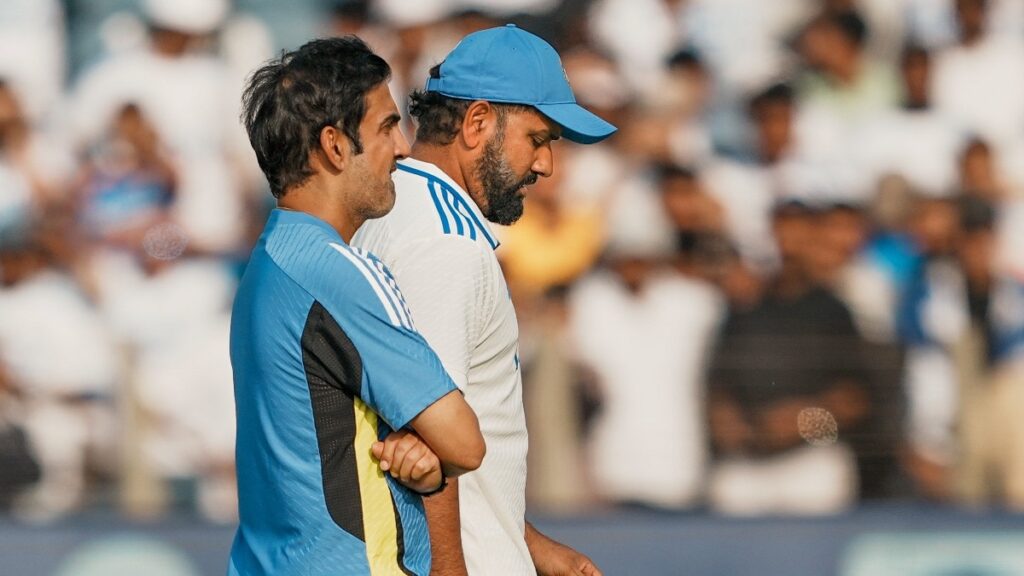As home fortress crumbles, Rohit-Gambhir combo shouldn't become the punching bag

An ODI series loss to Sri Lanka after 24 years, followed by a surprising defeat at home to New Zealand, has shattered the optimism surrounding the partnership of Rohit Sharma and Gautam Gambhir. What was anticipated as a new era of success after the T20 World Cup triumph has instead begun with a harsh reality check, leaving fans and pundits questioning the team’s direction.
India’s once-invincible home record in Test cricket was the envy of the world, and few expected it to collapse against one of the weakest touring sides in the World Test Championship. New Zealand, led by Tom Latham and without their star batter Kane Williamson, managed to achieve what Steve Smith’s Australia couldn’t in 2017.
New Zealand’s series win in India ranks amongst the greatest feats in cricket in the 21st century. India, nearly invincible at home, lost only two Tests from 2014 to 2021 under Virat Kohli. Even under Rohit, India had been slow starters in home Test series but always found ways to recover. However, New Zealand completely outplayed India over the first two Tests, leaving no room for a comeback. As the evening sun set in Pune, a streak of 18 Test series and 4,331 days came to a shuddering end.
“In 12 years, once (losing) is allowed,” Rohit stated, indicating he wouldn’t overreact to the defeat, especially ahead of a major tour of Australia. “Look at our record in India: out of 54 Tests, we’ve won 42. More good has happened than bad. It’s important to assess, but not so much that people start doubting themselves,” he added.
Is this the right perspective? Should India not be concerned about their performance over eight days, during which they lacked the familiar aura that unsettles visiting teams?
All TALK, NO SHOW?
Has there been too much talk without enough action? Did the series win against Bangladesh, particularly the miraculous sprint in Kanpur, lead to overconfidence? Did India underestimate New Zealand?
Before his first Test assignment, head coach Gautam Gambhir emphasised that India would not restrict themselves to any particular style of cricket and would adapt to different conditions. “We want to be the team that can score 400 runs in a day and bat for two days to save a Test match. That adaptability is the essence of Test cricket,” Gambhir stated after India’s record-breaking performance in Kanpur.
Yet, the reality was stark: India were bundled out for 46 in the first innings of the first Test, shaking their confidence. The subsequent innings were equally disappointing. Throughout the series, it seemed India was caught between two identities, struggling to define their batting style.
DISRESPECTING THE CONDITIONS
It was disheartening to see India disrespect the conditions in Bengaluru and Pune, something that hasn’t happened in the past. When touring teams complained about dust bowls, Indian batters historically demonstrated that runs could be scored by spending time and assessing conditions.
Rohit admitted making a mistake by winning the toss and opting to bat on an overcast morning in Bengaluru. The Indian batters paid the price for playing expansive shots against New Zealand’s high-quality seam attack, resulting in their lowest Test total at home. In the second innings of the first Test, despite better conditions, India collapsed from 408 for 3 to 462 all out.
In Pune, India again failed to respect spinner-friendly conditions. The pitch was far from the rank-turner of previous years, yet India was bowled out for 156 in the first innings and 245 in the second.
-
46 runs, 10 wickets (Bengaluru, first innings)
-
54 runs, 7 wickets (Bengaluru, second innings)
-
106 runs, 9 wickets (Pune, first innings)
-
51 runs, 5 wickets (Pune, second innings)
India made Mitchell Santner, who had never taken a Test five-wicket haul before this match, look like Muttiah Muralitharan.
TACTICAL BLUNDERS
Let’s not overlook the tactical blunders. India made several missteps in Bengaluru, from winning the toss and batting on an overcast morning to sending Virat Kohli in at No. 3.
The errors continued in Pune, where three changes were made despite previous reassurances that there was no need to panic.
Rohit faced criticism for not setting attacking fields in Pune, especially when New Zealand began their second innings with a lead of over 100 runs. Instead of pursuing wickets, India allowed New Zealand batters to rotate the strike freely. In contrast, Tom Latham kept Indian batters on their toes with more players in catching positions in the 30-yard circle.
ARE INDIA MORE VULNERABLE THAN EVER?
It’s clear that Rohit and Gambhir have not hit the mark. But is it fair to place all the blame on them?
Are we overlooking the fact that the Indian Test team is in a transition phase?
Rohit and Virat Kohli have struggled to consistently be effective in challenging conditions. Kohli’s average in India has dropped from 72.45 (2013-2019) to 32.86 since 2020, with a significant number of his dismissals coming against spin.
While the board has emphasised participation in domestic cricket, both Kohli and Rohit have shied away from red-ball tournaments, neglecting the need to fine-tune their game against spin. Even after retiring from T20Is, the superstar batters missed an opportunity to play red-ball cricket before the home Test season when they opted out of Duleep Trophy.
OFF-COLOUR SPIN TWINS
For the first time in many years, R. Ashwin and Ravindra Jadeja were off-colour in a home series. Ashwin conceded 94 runs in 16 overs in Bengaluru and, while he improved in Pune, was far from his best when needed. Jadeja bowled 18 overs without a wicket and a maiden in Pune’s first innings.
Numbers don’t lie — Washington Sundar, who was picked as the fifth-choice spinner in the series, outbowled both Ashwin and Jadeja in Pune.
Are Ashwin and Jadeja beginning to slow down like Kohli and Rohit?
Additionally, India’s lower-middle and lower order, famous for their rescue acts, failed against New Zealand. They averaged only 17.80 in this series, compared to 25.75 against England earlier this year.
As Rohit pointed out, even a fortress can crumble. After 12 years of dominance at home, this series serves as a stark warning.
India faced a similar transition under MS Dhoni, when the Test team struggled abroad before suffering a significant home loss to England. To avoid a repeat of that difficult period, India must evaluate its strengths and guard against complacency, especially with the challenging Border-Gavaskar Trophy ahead.
The next few months in Australia could spell disaster for careers if the team doesn’t rise to the occasion.







